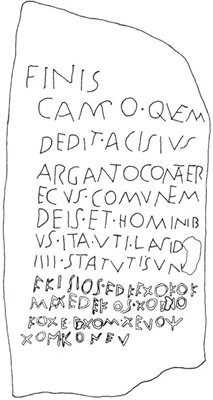
The
Celtic languages have long existed, not just in the British Isles’ history; but
also throughout mainland Europe. In the present day, there remain two
categories of Celtic language: Goedelic (Irish Gaelic, Scottish Gaelic, Manx)
and Brythonic (Breton, Cornish, Welsh, Cumbric). Today, we will explore their
European roots and how they came to be a staple throughout the British Isles
and ancient Europe, leaving the modern Goedelic and Brythonic languages for a follow-up
blog post.
Continental Celtic
(now extinct) classifies the languages spoken across Europe and Asia minor –
from Portugal to Turkey. The source of these languages likely originated from
the Urnfield culture, peoples who lived in groups as far back as 1200 BCE and
were located and spread across modern day southern France, Germany, Poland,
Austria, Hungary and even some parts of Ukraine and Romania. Scholars believe
their language to be a ‘Proto-Celtic’; with the evolution of this language
leading to the first widely documented Celtic language: Lepontic. Lepontic was
spoken in what is now Switzerland and northern Italy, around lake Como between
550 – 100 BC. Here is an example of their alphabet – with some letters looking similar
to the Western Greek script, a predecessor to the Latin script that you are
reading this text with!

A more widely known, but just as extinct example of these continental Celtic languages would be Gaulish, which existed before and partly alongside the Roman Empire in modern day France. Gaulish is found in around 800 inscriptions including on the likes of calendars, pottery, funeral monuments, venerated dedications, coins, statements of ownership and even some graffiti! The name of Swiss music group ‘Eluveitie’ comes from this graffiti; the word was scrawled on a vase in Mantua (Lombardy, Italy) and its meaning is likely of the Celtic ‘(h)elvetios’ (the Helvetian) referring to a man of Helvetian descent living in Mantua around 2350 years ago.
In this blog post, we will explore their European roots and how they came to be a staple throughout the British Isles and ancient Europe, leaving the modern Goedelic and Brythonic languages for a follow-up blog post.
Continental Celtic
(now extinct) classifies the languages spoken across Europe and Asia minor –
from Portugal to Turkey. The source of these languages likely originated from
the Urnfield culture, peoples who lived in groups as far back as 1200 BCE and
were located and spread across modern day southern France, Germany, Poland,
Austria, Hungary and even some parts of Ukraine and Romania. Scholars believe
their language to be a ‘Proto-Celtic’; with the evolution of this language
leading to the first widely documented Celtic language: Lepontic. Lepontic was
spoken in what is now Switzerland and northern Italy, around lake Como between
550 – 100 BC. Here is an example of their alphabet – with some letters looking similar
to the Western Greek script, a predecessor to the Latin script that you are
reading this text with!
A
more widely known, but just as extinct example of these continental Celtic
languages would be Gaulish, which existed before and partly alongside the Roman
Empire in modern day France. Gaulish is
found in around 800 inscriptions including on the likes of calendars, pottery,
funeral monuments, venerated dedications, coins, statements of ownership and
even some graffiti! The name of Swiss music group ‘Eluveitie’ comes from this
graffiti; the word was scrawled on a vase in Mantua (Lombardy, Italy) and its
meaning is likely of the Celtic ‘(h)elvetios’ (the Helvetian) referring
to a man of Helvetian descent living in Mantua around 2350 years ago.
Gaulish is believed to have survived as late as 5th century France. Despite considerable Romanization, the Gaulish language survived; coexisting alongside Latin during centuries of Roman rule of Gaul. Gaulish played a role in shaping the Vulgar Latin dialects that developed into French, with effects including loanwords, calques and sound changes. Gaulish likely played a role in gender shifts of words in Early French, where the gender of a noun shifted to match the gender of the corresponding Gaulish word of the same meaning. Some common examples of words in both Gaulish and modern French are: blé (wheat/corn); changer (to change/exchange); crème (cream); mouton (sheep) and cheval (horse).
Most Celtic speakers had died out or assimilated into Roman or Germanic speaking rule by around 200 BCE – however some scholars believe that before the death of these continental Celtic languages, some speakers migrated to the British Isles, paving the way for the insular Celtic languages of today, spoken by around 3 million people.
In a subsequent blog post, we will explore the history of these languages, leading to those that are learnt and spoken today.
